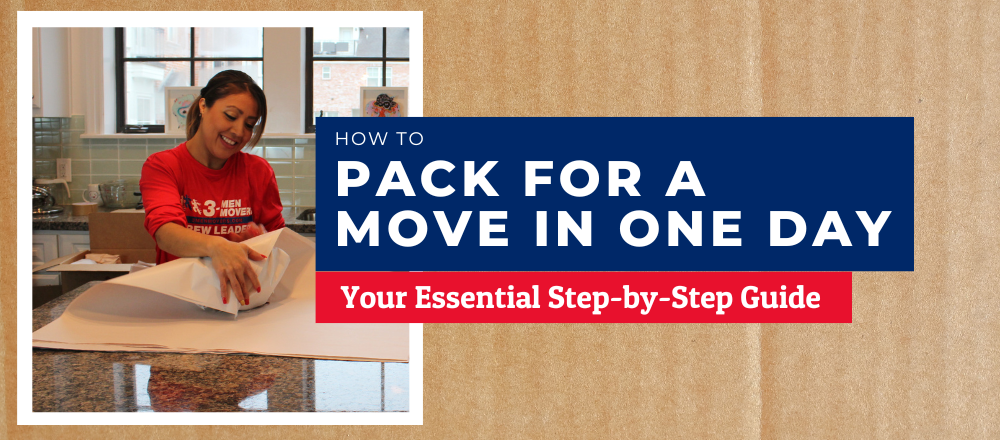

Got just one day to pack up your entire place? It might sound impossible—but with a little planning, the right supplies, and a focused mindset, you can knock it out without losing your mind (or your keys). Whether you’re dealing with a last-minute lease ending or the movers show up tomorrow, here’s how to pack quickly and smartly, all in one whirlwind day.
What Is the Fastest Way to Efficiently Pack for a Move?
The fastest way to pack is by starting early, working in focused sprints, and using a methodical room-by-room strategy. Don’t try to multitask across multiple rooms—efficiently pack by finishing one space before moving to the next. Use trash bags for soft goods, wardrobe boxes for hanging clothes, and keep your packing supplies nearby at all times so you're not wasting time searching for tape or labels. Speed comes from preparation, not rushing.
Stock Up on the Right Supplies the Night Before
The last thing you want to do on packing day is run out of tape. Or worse, try to improvise boxes using leftover Amazon deliveries and wishful thinking. Save yourself the scramble by gathering everything ahead of time:
-
Boxes (a mix of smaller boxes for heavy stuff and larger boxes for lighter items)
-
Packing tape (not masking tape—trust us)
-
Bubble wrap for those delicate and fragile items, like glassware or electronics
-
Packing paper for dishes, decor, and anything breakable
-
Markers and labels to note contents and rooms
-
Trash bags and plastic bags for clothing, soft goods, and miscellaneous items
If you’re not sure how much you’ll need, go big. Running out halfway through slows you down and eats up valuable time with unnecessary trips back and forth to the store.
Declutter First—Even if You’re in a Rush
Before you throw your whole life into boxes, pause. There’s no use in hauling stuff you don’t actually want or need. Keep a donate pile, a trash pile, and a “not sure yet” corner. If you wouldn’t buy it again or can’t see it in your next home, let it go.
Here's a few quick decluttering tips:
-
Pack a garbage bag just for donation items as you go
-
Set aside broken or outdated stuff for the trash
-
Ask yourself, “Will my future self thank me for moving this?”
This quick round of purging gives you more room to pack efficiently—and saves time later when you’re unpacking. You will be relieved you got rid of it and lightened your load.
Tackle One Room at a Time
Jumping from closet to kitchen to bathroom leads to chaos fast. Instead, start with one room separately, finish it, and move on. This method keeps your focus sharp and helps you stay organized, especially under a tight deadline.
Start with the areas you use least, like the dining room, guest room, or hall closet. Save high-use areas like the kitchen or bedroom for last, since you may need access to those items before the movers arrive.
Packing by entire room also helps when it’s time to label boxes and unpack. Everything stays together, making your new place easier to set up.
Use Specialty Boxes to Save Time
There’s a box for everything—literally. Invest in the right tools and let them do the heavy lifting (pun intended):
-
Wardrobe boxes let you move your closet without taking clothes off hangers
-
Dish packs and glassware boxes come with dividers and padding
-
Small boxes are ideal for books, tools, and heavy items
-
Larger boxes work better for pillows, bedding, and lighter stuff
Avoid overloading one big box with a mix of items. Packing similar things together not only makes lifting easier but prevents breakage.
Use Suitcases, Totes, and Trash Bags
Don’t overlook what you already have. Fill your suitcases with clean clothes, shoes, or personal items. Use plastic bags for stuffed animals, towels, or laundry. Drawstring garbage bags are perfect for clothes you’re okay folding later—tie hangers together and slide them inside.
Got a bedroom dresser? Leave lightweight items inside and wrap drawers with plastic wrap or masking tape to keep them from sliding open. Maximize your floor space with this trick and save time boxing smaller items.
Stay Organized While You Pack
Efficiency doesn’t mean being messy. A few quick systems will help your day run smoother:
-
Label boxes on multiple sides with the room and a short description (“Kitchen – Pans & Utensils”)
-
Use color-coded stickers or tape by room for quick sorting
-
Keep an inventory list in your phone, especially for important documents or electronics
This not only helps you stay sane during the packing process, but it’ll make unpacking easier when you arrive.
Create a Packing Game Plan
A one-day move needs structure. Here’s a sample timeline:
7:30 AM – Wake up, caffeinate, and eat a solid breakfast
8:00 AM – Finalize supplies, start with least-used room
10:00 AM – Pack breakables and decor
12:00 PM – Quick lunch + declutter round 2
1:00 PM – Pack kitchen and living room
3:00 PM – Bathroom, bedroom, and clothes
6:00 PM – Load packed items into a staging area
8:00 PM – Clean, double-check rooms, prep your essentials bag
Set alarms or reminders if needed. Even just 15-minute check-ins help you stay organized and prevent distractions.
Save Time by Prepping Furniture
Bulky items don’t pack themselves—but you can prep them to make moving faster. Disassemble anything that can be broken down safely: bed frames, desks, dining tables.
Label the pieces using masking tape, and put screws or parts in a plastic bag taped to the furniture. This step saves time loading the moving truck and helps professional movers reassemble things quickly at your destination.
If you’re lifting heavy boxes, bend at your knees, not your back—or better yet, let your movers handle the big stuff.
Keep a “First Night” Essentials Box
No matter how much you pack in one day, you’ll want a few basics handy when you land in your new place. Pack a separate bag or box with:
-
Toilet paper
-
Coffee maker (or instant coffee!)
-
Bedding and pajamas
-
Chargers and toiletries
-
Snacks and bottled water
-
A fresh outfit and clean clothes
-
Important documents and meds
This is your emergency kit for the first 24 hours post-move. Don’t bury it in the back of the van!
Know When to Call the Pros (Moving Companies)
If it’s starting to feel like too much—because let’s be honest, packing a home in a single day is no small task—there’s no shame in calling for backup.
Professional packers and movers know how to handle time crunches. They come with their own packing supplies, handle your fragile items with care, and can tackle the moving process from start to finish.
When booking moving services, try to schedule at least a week in advance (or sooner during peak times). Using a trustworthy and reliable moving company can be the difference between smooth sailing and a full-on panic spiral.
Common One-Day Packing Mistakes (and How to Avoid Them)
Even the best intentions can go sideways. Here are a few pitfalls to watch for:
-
Overpacking boxes: Always pack heavier items like books in smaller boxes
-
Forgetting to label: You’ll regret it at midnight when you’re hunting for your toothbrush
-
Mixing rooms: Keep items from different rooms in their own containers
-
Skipping meals or breaks: You need energy to push through
-
Procrastinating: It’s tempting to “just check Instagram”—don’t
Keep these in mind, and you’ll move faster and smarter.
Make the Most of Your Moving Truck Space
Loading the moving van isn’t just a matter of shoving boxes in. The better it’s packed, the fewer trips you need—and the less chance something breaks.
-
Place heavy boxes on the bottom
-
Use soft items (pillows, blankets) as padding
-
Stack boxes by weight and fragility
-
Don’t leave empty space—use it for smaller items
If you’re working with professional moving companies, they’ll usually take care of loading. Still, having your packing boxes prepped and labeled saves everyone time.
Final Sweep: Don’t Skip This Step
Before you call it a wrap (pun intended), do a full walkthrough of your space. Check closets, under sinks, and behind doors. Run through this quick checklist:
-
Nothing left behind in drawers or cabinets
-
Trash and donation items removed
-
Boxes stacked near the door for easy loading
-
Furniture disassembled and ready
-
All rooms finish packing completely
-
Keys, lease paperwork, and move-out info prepped
Then, take a deep breath. You just packed an entire apartment in one day. Seriously—go you.
Moving Doesn’t Have to Be a Mess
Sure, cramming an entire move into one day sounds chaotic. But with the right supplies, a few smart strategies, and a willingness to let go of stuff you don’t need, you can pack up your apartment and still have time to sleep before moving day. And if you're looking for extra hands or a team to trust, our crew at 3 Men Movers is here to help—whether you're moving in a rush or planning ahead.